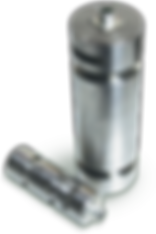What Is a Load Pin?
- Weighing News
- 1 day ago
- 2 min read
Load pins are load cells used in overhead weighing applications. By replacing clevis, sheave pins or other small components, load pins can be directly integrated into cranes to track weights.
Load Pin Basics

A load pin is a type of load cell used as a direct replacement for clevis, sheave, pivot, normal shaft, or equalize pins. In a hook block on a bridge crane, load pins are reliable, easy-to-install overhead weighing solutions, many of which have capacities over 500,000 pounds. Load pins are designed to be permanently installed in a sheave, pulley or crane system to consistently monitor vertical or horizontal tension.
How Do Load Pins Work?
Load pins have a bored center containing internal, force-measuring strain gauges. Like other load sensors, these strain gauges measure the change in electrical signal caused by applied force in a specific direction. The change is then converted to a weight measurement.

The exterior circumference of a load pin has two grooves to define the area of the pin between the measured forces. The lug or sheave applies force in one direction on the middle section of the pin, while the fixed support applies pressure in the opposite direction. This is the force, or tension, measured by load pin strain gauges.
Integrated overhead weighing solutions like load pins provide load monitoring and overload protection without impacting the headroom of an application. Load monitoring with an integrated load pin promotes safety and prevents costly overload damage.
Where are load pins used?
A wide range of industries benefit from integrated overhead weighing solutions, including agriculture, chemical processing, energy production, marine cargo and port shipping operations. Integrated load pins can be used with almost any application with a repeatable load path, including:
Cranes (mobile, bridge, jib, gantry and straddle)
Winches
Elevators
Hoisting gear
Sheaves
Shackles
Bearing blocks
Pivots
